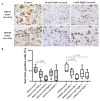The Comparative Experimental Study of Sodium and Magnesium Dichloroacetate Effects on Pediatric PBT24 and SF8628 Cell Glioblastoma Tumors Using a Chicken Embryo Chorioallantoic Membrane Model and on Cells In Vitro
- PMID: 36142368
- PMCID: PMC9499689
- DOI: 10.3390/ijms231810455
The Comparative Experimental Study of Sodium and Magnesium Dichloroacetate Effects on Pediatric PBT24 and SF8628 Cell Glioblastoma Tumors Using a Chicken Embryo Chorioallantoic Membrane Model and on Cells In Vitro
Abstract
In this study, pyruvate dehydrogenase kinase-1 inhibition with dichloroacetate (DCA) was explored as an alternative cancer therapy. The study's aim was to compare the effectiveness of NaDCA and MgDCA on pediatric glioblastoma PBT24 and SF8628 tumors and cells. The treatment effects were evaluated on xenografts growth on a chicken embryo chorioallantoic membrane. The PCNA, EZH2, p53, survivin expression in tumor, and the SLC12A2, SLC12A5, SLC5A8, CDH1, and CDH2 expression in cells were studied. The tumor groups were: control, cells treated with 10 mM and 5 mM of NaDCA, and 5 mM and 2.5 mM of MgDCA. The cells were also treated with 3 mM DCA. Both the 10 mM DCA preparations significantly reduced PBT24 and SF8624 tumor invasion rates, while 5 mM NaDCA reduced it only in the SF8628 tumors. The 5 mM MgDCA inhibited tumor-associated neoangiogenesis in PBT24; both doses of NaDCA inhibited tumor-associated neoangiogenesis in SF8628. The 10 mM DCA inhibited the expression of markers tested in PBT24 and SF8628 tumors, but the 5 mM DCA affect on their expression depended on the cation. The DCA treatment did not affect the SLC12A2, SLC12A5, and SLC5A8 expression in cells but increased CDH1 expression in SF8628. The tumor response to DCA at different doses indicated that a contrast between NaDCA and MgDCA effectiveness reflects the differences in the tested cells' biologies.
Keywords: CAM model; PBT24; SF8628; dichloroacetate; gene expression; pediatric glioblastoma; sex.
Conflict of interest statement
The authors declare no conflict of interest.
Figures








Similar articles
-
In Vivo and In Vitro Experimental Study Comparing the Effect of a Combination of Sodium Dichloroacetate and Valproic Acid with That of Temozolomide on Adult Glioblastoma.Int J Mol Sci. 2025 Jul 15;26(14):6784. doi: 10.3390/ijms26146784. Int J Mol Sci. 2025. PMID: 40725030 Free PMC article.
-
The Effectiveness of Dichloroacetate on Human Glioblastoma Xenograft Growth Depends on Na+ and Mg2+ Cations.Dose Response. 2021 Feb 27;19(1):1559325821990166. doi: 10.1177/1559325821990166. eCollection 2021 Jan-Mar. Dose Response. 2021. PMID: 33716589 Free PMC article.
-
Different Effects of Valproic Acid on SLC12A2, SLC12A5 and SLC5A8 Gene Expression in Pediatric Glioblastoma Cells as an Approach to Personalised Therapy.Biomedicines. 2022 Apr 22;10(5):968. doi: 10.3390/biomedicines10050968. Biomedicines. 2022. PMID: 35625705 Free PMC article.
-
Therapeutic applications of dichloroacetate and the role of glutathione transferase zeta-1.Pharmacol Ther. 2017 Feb;170:166-180. doi: 10.1016/j.pharmthera.2016.10.018. Epub 2016 Oct 19. Pharmacol Ther. 2017. PMID: 27771434 Free PMC article. Review.
-
Effects of various doses of sodium dichloroacetate on hyperlactatemia in fed ischemic rats.Ann Emerg Med. 1989 Nov;18(11):1162-71. doi: 10.1016/s0196-0644(89)80053-8. Ann Emerg Med. 1989. PMID: 2683899 Review.
Cited by
-
Effects of Combined Treatment with Sodium Dichloroacetate and Sodium Valproate on the Genes in Inflammation- and Immune-Related Pathways in T Lymphocytes from Patients with SARS-CoV-2 Infection with Pneumonia: Sex-Related Differences.Pharmaceutics. 2024 Mar 16;16(3):409. doi: 10.3390/pharmaceutics16030409. Pharmaceutics. 2024. PMID: 38543303 Free PMC article.
-
The opportunities and challenges for nutritional intervention in childhood cancers.Front Nutr. 2023 Feb 13;10:1091067. doi: 10.3389/fnut.2023.1091067. eCollection 2023. Front Nutr. 2023. PMID: 36925958 Free PMC article. Review.
-
In Vivo and In Vitro Experimental Study Comparing the Effect of a Combination of Sodium Dichloroacetate and Valproic Acid with That of Temozolomide on Adult Glioblastoma.Int J Mol Sci. 2025 Jul 15;26(14):6784. doi: 10.3390/ijms26146784. Int J Mol Sci. 2025. PMID: 40725030 Free PMC article.
-
Different Approaches to Study Molecular Blueprint and Biological Behavior of Brain Tumors: Editorial to the Special Issue "Advances in Molecular Genetics of Brain Tumors".Int J Mol Sci. 2023 Jan 4;24(2):948. doi: 10.3390/ijms24020948. Int J Mol Sci. 2023. PMID: 36674461 Free PMC article.
References
-
- Garofano L., Migliozzi S., Oh Y.T., D’Angelo F., Najac R.D., Ko A., Frangaj B., Caruso F.P., Yu K., Yuan J., et al. Pathway-Based Classification of Glioblastoma Uncovers a Mitochondrial Subtype with Therapeutic Vulnerabilities. Nat. Cancer. 2021;2:141–156. doi: 10.1038/s43018-020-00159-4. - DOI - PMC - PubMed
-
- Chung C., Sweha S.R., Pratt D., Tamrazi B., Panwalkar P., Banda A., Bayliss J., Hawes D., Yang F., Lee H.-J., et al. Integrated Metabolic and Epigenomic Reprograming by H3K27M Mutations in Diffuse Intrinsic Pontine Gliomas. Cancer Cell. 2020;38:334–349.e9. doi: 10.1016/j.ccell.2020.07.008. - DOI - PMC - PubMed
-
- Duraj T., García-Romero N., Carrión-Navarro J., Madurga R., Mendivil A.O., de Prat-Acin R., Garcia-Cañamaque L., Ayuso-Sacido A. Beyond the Warburg Effect: Oxidative and Glycolytic Phenotypes Coexist within the Metabolic Heterogeneity of Glioblastoma. Cells. 2021;10:202. doi: 10.3390/cells10020202. - DOI - PMC - PubMed
MeSH terms
Substances
Grants and funding
LinkOut - more resources
Full Text Sources
Research Materials
Miscellaneous

